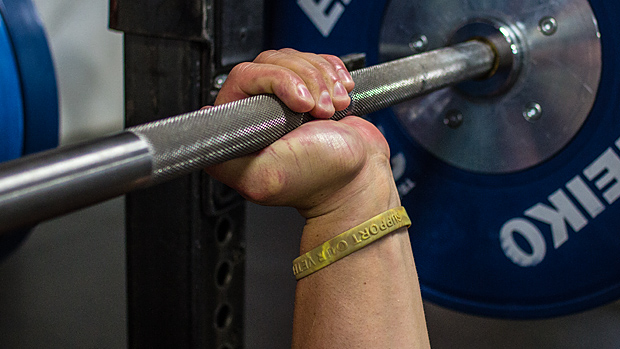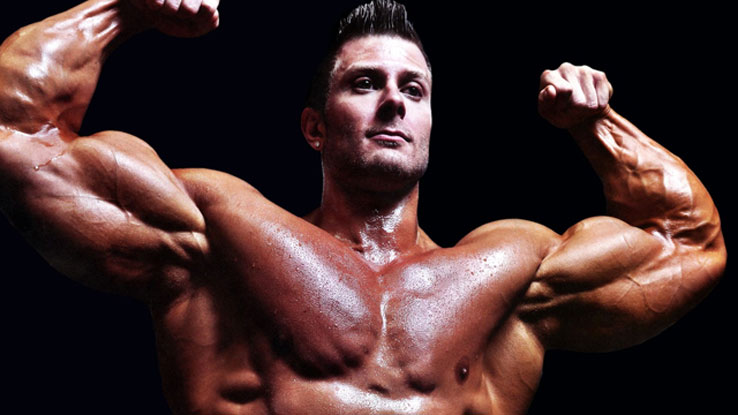It's Suicide... Or Is It?
We've all heard the warnings about it. They say lifters have gotten their necks crushed by barbells which have slipped right out of their hands during the bench press. Maybe this is why the thumbless or false grip is also known as the "suicide" grip.
But in spite of the risks, many of the biggest, strongest lifters choose the notorious false grip for bench pressing. Why? Because it puts them in a unique position which optimizes shoulder health and movement patterning. And it's not just for bench pressing, it works for overhead presses too.
Problem is, lifters aren't educated on the proper way to do it. If you're struggling with chronically banged-up shoulders, your long-term fix may actually be simpler than you thought... but risky if you don't do it right.
Here's how the false grip can instantaneously improve your shoulder positions for stronger, pain-free pressing, plus four lifts to use so you can start pressing with a false grip right away.
Contrary to what some coaches say, bench pressing with a false grip is not the equivalent to sticking your neck under a guillotine. When it comes to the false-grip press, there's absolutely a correct way to do it that'll keep you safe, but this usually gets overlooked by those who've never been taught how.
Here are a few nonnegotiable false-grip setup cues to maximize safety:
- Always use a spotter for un-racking and re-racking.
- Ensure the barbell is not slippery. Use chalk, and a lot of it.
- Place the bar in the midline of your palm, NOT in your fingertips.
- Actively squeeze the barbell with all five fingers throughout the lift.
- Engage the forearms to minimize dumping of the wrist into extension.
- Keep torso and hip position solid and stable. No cheat reps allowed.
If you can follow the basic rules, you'll be safe and have an awesome set.
Still balking at the "inherent risk" involved with not wrapping your thumb around the bar? Remember one thing. The risk of almost everything we do in training can be minimized with focus and attention to detail upon setup and proper execution under load. That means you alone have the ultimate control over your orthopedic health, so respect the iron and it will respect your medical status.
Long term resilience at the shoulders is dependent on many factors, but none of them are more important than achieving as neutral of a joint position as possible throughout as much of the range of motion as possible.
This neutral position in a ball-and-socket joint like the glenohumeral joint (the true shoulder joint) is referred to as joint centration. Mastering the skill of shoulder centration can unlock strength potential while mitigating the risk of joint stress, overuse, and dysfunction.
The problem many lifters encounter with the bench press is a lack of a neutrally stabilized shoulder position. Instead, many fall into forced internally rotated moments at the shoulder joint under load, which creates a problem with the upper back and the scapular stability that's required to stabilize the shoulders. This destabilized and internally-rotated position is usually exacerbated by a full grip on the bar, creating more elbow flare and front-sided structural stress on the shoulders.
While the first course of action to engage and activate the upper back and lats, sometimes the added stability isn't enough when structures of the shoulders are chronically irritated and dysfunctional. Pain changes everything, including muscular activation, fluid dynamic stability, and neural drive. So if and when improving posterior chain stability doesn't work, the next step is to improve your natural and individualized biomechanical positioning.
When fixing faulty lifts, start by placing the body into the most biomechanically advantageous positions. For both bench and overhead pressing, this means creating a centrated moment at the shoulders.
Sound complicated? The good news is, you can do it simply with the false grip on the bar. By placing the thumb next to the other four fingers on one side of the bar and actively stabilizing the hand and wrist, you can reduce the amount of internal rotation and flared "elbows out" position that's associated with a painful press.
The ideal humeral carrying angle for the average person is going to be around 35-60 degrees – halfway between straight down to your sides and elevated up at a right angle. The false grip allows the hands to be slightly more supinated in relation to bar contact, a position which travels up the chain through the forearm and elbow positioning. This helps keep the elbows relatively closer to your sides, again in a more centrated position.
If you're having trouble determining your optimal humeral carrying angle, simply get your hands shoulder-width apart on the bar in a false grip and squeeze all five fingers and your forearms hard. Your pecs, lats, and upper extremities should be maximally contracted, and when they are, your carrying angle will be able to be neurologically fine-tuned for stability and proper angles upon setup for pressing.
Theory is only as useful as your application of it. So here are the four major pressing exercises you should be using a false grip with, especially if you've been dealing with pissed-off shoulders or stagnated pressing performance.
Not everyone should overhead press a barbell. There are often postural restrictions, stability issues, or motor control deficits. But for those who are able to maintain a neutral spinal position, keep the rib cage from flaring, and have the mobility to press overhead without pain or dysfunction, then the false grip can be an extremely useful tool.
Your press should start from the rack in order to optimize the grip, shoulder position, and pillar stability before any dynamic pressing happens. Stabilize your grip and shoulders under the bar first, then walk back with control just as you would a heavy squat.
While maintaining neutral pillar positioning throughout the press, make sure you tap into the stable power of the irradiation effect by gripping all five fingers against the bar maximally. Engage on the way up, and maintain stability through accentuating the eccentric (slowly lowering) on the way down.
Remember that safety rule about NOT using momentum or compensation with the false grip? That goes for overhead pressing as well, so to keep the bar from falling down and knocking you out, avoid push pressing or momentum-based overhead work here.
While I don't usually recommend using the false grip on flat or decline bench pressing, it does provide a huge amount of benefit for pressing around shoulder pain on an incline. Over the last decade, we've transitioned more athletes to predominantly incline pressing with the false grip in order to nail the pecs and shoulders while minimizing unwanted joint stress.
Un-racking the bar with a stabilized false grip can be a bit tricky, and it's no surprise that many training-related injuries actually happen as a result of poor setups as opposed to the actual lifts. So use a spotter to help guide the bar out from the rack and back into the rack after the set.
Practice the setup on all angles including slight and high-angle presses and develop the skill of stability at the shoulders in a neutral position. If you've been pressing with a traditional grip, the false grip may force you to lower your weight at first, but as your skillset increases, your numbers will eventually surpass your previous bests. Sparing the joints and targeting more musculature bodes well for long term strength, power, and aesthetics.
I don't always program Smith machine presses, but when I do I use a false grip. If you're accustomed to using it for the press, or want to take a walk on the wild side of highly non-functional training (I kid, I kid) the Smith machine can give you one hell of a contraction for the pecs and shoulders... but only when setup, bench angle, and form are right.
Many Smith machines have a predetermined bar path that's usually not straight up and down. Many have slight angles that bring the bar further down the chest as the bar nears the bottom position, and then brings the bar closer to the eyes at the top of the lift. This change in planes usually ends up with lifters flaring their elbows, protracting their shoulder blades, and losing all resemblance of upper back tension and stability.
We can avoid this by centrating the shoulders right off the bat, and allowing natural changes in carrying angle to happen without risk of forced and loaded internal rotation. Luckily, the false grip on the Smith machine limits unwanted positions at the end range. Take your time on the setup and racking here since it involves some wrist flexion and extension to get into position to press. Make sure you have solid control of your hands, wrists, and forearms before pressing.
Pressing against a machine in an awkward seated position usually causes an elevation, protraction, and internal rotation at the shoulder that's not ideal for shoulder health and pressing proficiency. Bring the elbows down and stabilize better by using the thumbless grip. This simple adjustment will minimize the compounded joint stress from this machine.
One last note on machine training in general: Make sure you optimize your setup by fitting the adjustments to your body. For the chest press, the seat must be elevated to a level where the pressing handles sit about at your nipple line. Above or below will deter away from the trainability of this movement, and should only be utilized strategically for accessory pressing movements or isolation training.





